Habitat III in Quito (Oct 17-20) — Part One
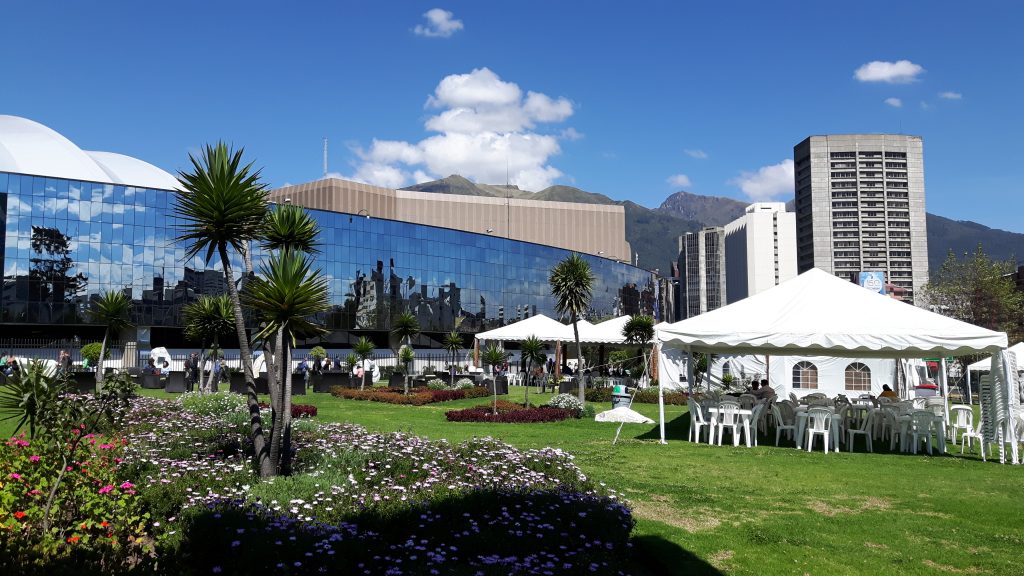
Casa de Cultura and Parque el Arbolito during Habitat III
John and I were among the 30,000 people attending Habitat III his week: UN Conference on Housing and Sustainable Urban Development. It’s the first UN event we’ve attended so we wondered how it would compare to professional conferences in the US. John was excited about networking opportunities regarding his work with Citizens’ Climate Lobby. I was happy to tag along.
Habitat III is the third such UN Conference, after Vancouver in 1976 and Istanbul in 1996. In the last 40 years, the urban population of the world has gone from 38% to 54% so cities and mayors are increasingly important in solving global sustainability issues. Cuenca was recognized as a Global Green City at Habitat III for its parks and the Tranvia (light rail system, under construction).

Festival of Light, a light show at La Merced Church was a highlight of the event
There were over 100 presentations and events open to the public each day in multiple venues! The main venue was the Casa de Cultura, shown above, next to Parque El Ejido and Parque El Arbolito. Up the street were multiple Exhibition Halls with “vendors” including countries, municipalities, professional organizations, and private businesses. Around town Habitat 3 Village events were located. And for 5 evenings in a row, the Festival of Lights in historic Quito dazzled spectators. 250,000 people attended the Festival of Lights on Sunday alone. (More about this and how we almost got trampled to death by the crowd in Part 2.)
It all seemed great, until we tried to get registered (1 – 3 hours), get through 3 to 4 hour lines due to having only 5 security scanners for 25,000 people going to Casa de Cultura, find out what events were happening when and where (website was down a lot and no paper printouts at conference). (We used our tercer edad status avoiding 4 hr lines!)
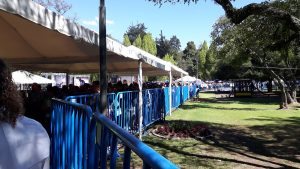
Long lines to get into Casa de Cultura – main venue.
Getting access to presentations was hit or miss. Rooms were tiny and lines to attend long. All in all, a great deal of time and effort to attend a few sessions per day. Ugh.
However, it was a good networking event. Good conversations after sessions or while waiting in lines. The Exhibition Hall had short lines, many interesting booths, and easy networking for John, who got to talk to both the national director of American Planning Association AND the international director, to spur both to ask their legislators about climate change action.. In general, Habitat 3 is less about education and more about consensus-building by UN member nations than the professional conferences we attend in US. Many locals who wanted to attend could not due to long lines for registration, the Casa de Cultura, and meeting rooms.
Michael Kimmelman, architecture critic for the New York Times, sums up the best about Habitat III:
Today, progressive thinking, reinforced by the undeniability of climate change, has overturned those [old] ideas [that cities are the problem]. Cities are being recognized increasingly as opportunities for economic and social progress, density as a response to environmental threats; the automobile as a big problem; slums not just as a blight but a potential template for organic urbanism. Young generations around the world, entering the tech economy and bound by the internet, are embracing urban ideals, including the common ground of public spaces, mass transit, streets and sidewalks.
Highlights of our Attendance:
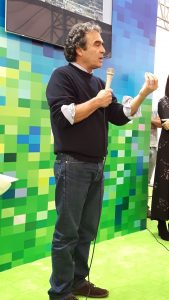
Sergio Fajado at The Netherlands Exhibit
- Sergio Fajado, award-winning mayor of Medellin (2003-2007) and governor of the Dept of Antioquia (2012-2015) gave an engaging talk about his decision to DO something because he was tired of saying “this should be done”. Although a Ph.D. mathematician and journalist, he turned to politics in 2000 because “politicians make the most important decisions in our society”. He spent 4 years building a movement in Medellin, 4 years as mayor, and 4 years as governor of Antioquia. When asked about paying for all the public works completed in poor Medellin neighborhoods (schools, parks, housing, community centers, a pedestrian bridge, cable car), he replied the “people will pay taxes once they see good public works and see improvement in their lives.” Success involved continuing discussions with people in communities along the entire process, after establishing a relationship of trust. One of the dozens of examples was a pedestrian bridge built over a dangerous ravine between 2 rival communities. The bridge provided safe means of traveling between communities and violence in the ravine ceased, relations between the 2 communities transformed. Kudos to The Netherlands Exhibit for inviting Dr. Fajado! Dr. Fajado recently announced he is running for President of Colombia in 2018.
- Affordable Housing Solutions — Barcelona Housing Systems, CNBM (China National Building Materials Group), & Empresa Publica de Vivienda. A model was built of a pre-fabbed, 4-story housing system which uses no cement or water (but lots of metal) at the Parque Itchimbia. Walls and ceiling contain fiberglass insulation, kitchen included induction cooktops, and doors & windows are air-tight & sound-reducing dual-glazed PVC. Ecuador just signed an agreement to have 1500 units built in Ecuador. The cost for the 58 s.m. 2 bed, 2 bath units was to be around $45,000 including cost of land. A 3 bedroom model would be slightly more expensive. John’s observations: 1) this system is designed to be “one size fits all climates” and we know this is not true for housing: eg, insulation needs for Latvia and Quito are very different. 2) Why use very thick gauge metal (aluminum and steel) in 100% of building, when thinner gauge metal, or better yet, bamboo, would do the trick in much of the building? The embodied energy of metal is HIGH — carbon intense. Fun concept: the windows you see in the picture to lower left are also doors with small interior balconies!
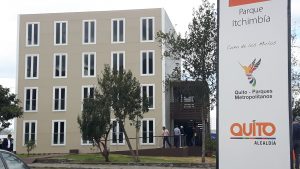
Model of Barcelona Housing Systems at Itchimbia Park
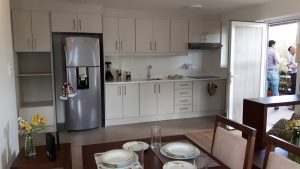
Model of kitchen and living area
- Vive Alameda — La Alameda Park and Alameda neighborhood are located between the historic center and the modern neighborhoods to the north. By creating trust and opening dialogue with residents, a Quito
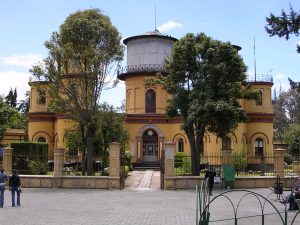
The Astronomical Observatory, circa 1873
group under auspices of Mayor’s office (“linq” — Laboratorio de Innovacion Quito) in collaboration with an international group (ICOMOS – International Council on Monuments and Sites) has tried to create a more “resilient” neighborhood using its cultural heritage. The Alameda residents surprised them by choosing an all-glass high rise building, a street food vendor (in business 30 yrs), a church outside their neighborhood, and the 19th century astronomical observatory in the park among the things they cherish and associated with their neighborhood. Discussions were ongoing with residents about to proceed.
-
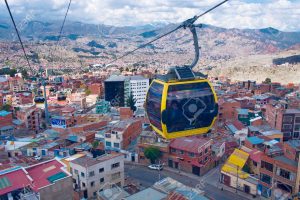
One of 3 cable car lines in La Paz, Bolivia. Opened in 2015.
- Urban Cable Cars — I’m glad I was persistent! It took 30 minutes to get into this panel session — I missed the first half — but managed to see most of the presentation by Cesar Dockweiler Suarez, CEO, Mi Teleferico, La Paz, Bolivia. La Paz has built the world’s tallest cable car system which is unique in being a primary means of transport and, according to Dockweiler, in paying for itself in 35 years per projections! Construction costs in La Paz are very low, as compared to those in Colombia, making it very cost effective. A ride costs about 40 cents. There are other benefits to using cable cars over buses and light rail in this dense urban mountain setting– passenger safety, CO2 emissions relatively low, and passengers enjoy views of the city rather than congested traffic. The limitations (not mentioned in panel) of gondola-style cable cars are low velocities and limited space for baggage. *Quito has an effort to install cable cars between the city and the Valley of Tumbaco, populated by urban sprawl. It’s called Metroferico.*
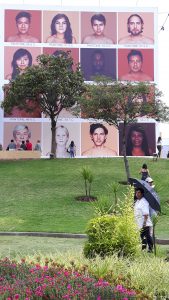
Faces Exhibit, Habitat III
- Culture in Quito: Quito’s Secretariat of Culture, Pablo Corral Vega, a renowned Ecuadorian photojournalist, asked the audiencee how it was that with a $23 million budget the Secretaria de Cultura (and government in general) did not represent the diversity of the city. They have a budget for theaters, museums, and events but not for activites that are more inclusive of the public. With this in mind, he hired a fellow photographer, from Brazil, to 1) plan the “Festival of Lights” so public spaces would be filled with people and it would open up new dialogues and 2) develope the “Faces Exhibit” seen in El Arbolito Park during Habitat III: there were no barriers between the faces — all Ecuadorian — of young and old, men and women, of all skin colors. Recently, the Secretaria also sponsored 3 fiestas focusing on 1 of 3 ethnic groups each weekend: Afr0-ecuadorian, Indigenous, and Mestizo. The response from the afro-ecuadorian community was especially positive, he said. Another related project was described by an associate of Corral’s: Parque Urbano Cumanda. She related how the old Cumanda bus station was transformed into a Cultural Center for arts and sports, open 13 hrs each day with 40 activities each day, and a theater space, in which a documentary film festival was held. The Cumanda area is working class and it has open up opportunities for locals.
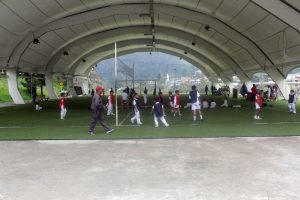
Volleyball & Soccer playground, Cumanda

Ping Pong area at Cumanda Urban Park
Overall, we enjoyed Habitat III, met people from across the world, and learned how the best managed cities are changing the world for the better.
Note: This post was a bit book report-like, so if you made it this far, glad you enjoyed. Part 2 will cover our stay in Quito and entertainment at Habitat III.

Habitat III – Quito
Category: Quito, Travels in Ecuador




nice to hear and see a brief report.
re: culture
festival of lights: electric? pv? a bridge too far?
fiestas…sometimes these are = to siestas. did anglosaxonnorteamericanos fit? photographers?
China housing: reports are that China is expatriating some many, many thousands to Africa and the Americas. with notable agendas beyond kindly relief of suffering. Observations?
NYT snippet: continuing a yawning history of bland leveling, kneeling to power.
See you in December.
Glad you enjoyed. More to come about “fiesta de la luz” shortly! Lights were presumably electric (although PV is occasionally used) and light shows were videos projected on church(es), with music. Over 99% at the fiesta participants were locals AND it was DARK. Who knows about norte-americanos? As for the Chinese, they are not popular here. They loaned Ecuador money (which Ecuador is careful to pay back even when difficult) and are building hydro-electric plants with use of Chinese labor and too few local laborers according to some critics. Stay well. Til December.